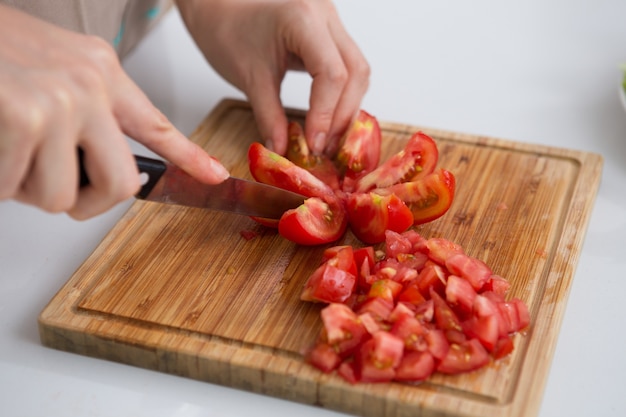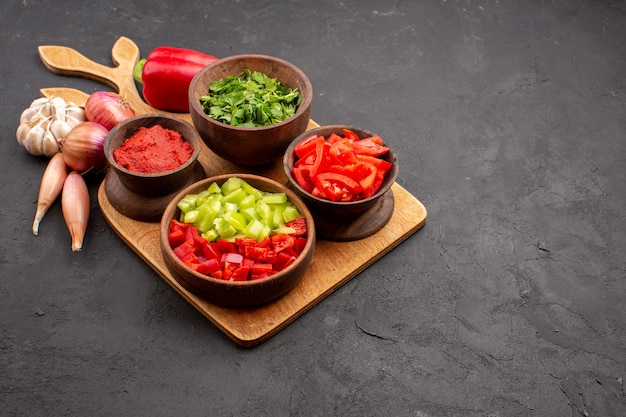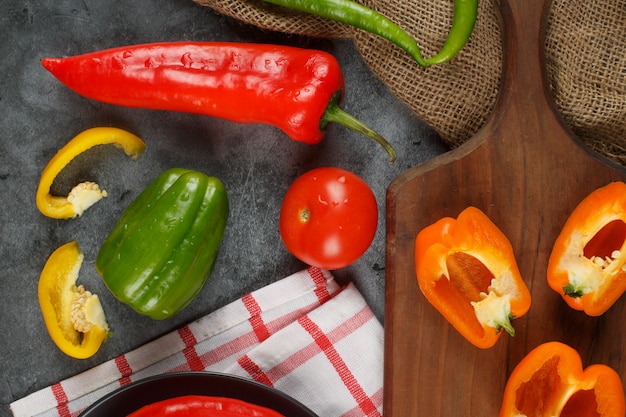There's nothing quite like the aroma of chili bubbling away in a slow cooker, filling your home with the promise of a delicious and comforting meal. It's a dish that embodies warmth, both in its flavour and the feeling it evokes. But how long do you actually cook chili for? It's a question that often sparks debate amongst chili enthusiasts, and the answer, as you might expect, isn't as simple as it seems.
This article dives deep into the world of slow-cooked chili, exploring the science behind its magic, the nuances of timing, and the art of creating a truly unforgettable pot of chili. Get ready to embrace the process, learn from my own chili-making adventures, and discover the secrets to achieving that perfect, melt-in-your-mouth chili you've always dreamed of.
(Part 1) The Slow-Cooker's Secret Weapon: Time

Let's be honest, the joy of slow-cooking chili lies in its simplicity and the sheer deliciousness that unfolds over time. It's not just about convenience, although that's a major perk, it's about creating a symphony of flavour where every ingredient harmonizes perfectly.
The Science Behind slow cooking
Imagine a gentle dance between heat and ingredients. That's essentially what happens in a slow cooker. The low and steady heat encourages tough proteins in the meat to break down, releasing their rich juices. These juices mingle with the other ingredients, like beans, tomatoes, and spices, deepening and intensifying the overall flavour.
Think about it: you wouldn't expect a tender steak to be cooked over high heat for a short time, would you? It would be dry and tough. The same principle applies to chili. Slow cooking allows the tough cuts of meat, like chuck roast or brisket, to become so tender they practically melt in your mouth.
My Chili-Making Journey: Trial and Error
I've been on my own chili-making journey for years, experimenting with different recipes and techniques. I've definitely had my share of culinary mishaps, like the time I tried to impress my neighbours with a "quick" chili. It was edible, but the beans were a bit firm, and the overall flavour lacked that deep richness I crave. It was a stark contrast to the slow-cooked chili I made the next week, a revelation of flavour, where the beans were so tender they practically dissolved on my tongue.
(Part 2) The Sweet Spot: Finding Your Chili's Perfect Time

Now, the question everyone wants answered: how long is "long enough"? Sadly, there's no magic number that works for every chili. It depends on a few factors:
1. The Type of Meat
choosing the right cut of meat is crucial. Tougher cuts like chuck roast or shoulder need more time to break down than leaner cuts like sirloin. Beef, pork, chicken, and even combinations can all work beautifully in chili, but each type has its own unique cooking time.
2. The Size of the Meat
This might seem obvious, but a large chunk of meat takes longer to cook than a stew meat cube. Consider chopping your meat into smaller pieces for faster cooking time.
3. The Type of Slow Cooker
Slow cookers come in different sizes and power settings. Some heat up faster than others, and a high setting will obviously cook your chili faster than a low setting.
4. Your Desired Tenderness
Do you want a chili with a hearty bite, where you can still feel the texture of the meat and beans, or are you aiming for a luxuriously smooth, melt-in-your-mouth consistency? This will influence how long you cook your chili.
(Part 3) A Chili Timeline: From Quick to Super Slow

To help you navigate the world of chili timing, here's a general guideline based on different meat types and desired tenderness:
Short and Sweet (4-6 hours):
Perfect for: Leaner meats like ground beef or chicken breast, smaller cuts of meat, those who prefer a slightly firmer chili texture.
Tip: Opt for a high setting to expedite the cooking process.
The Classic (6-8 hours):
Perfect for: Most types of beef, pork, and chicken, a good balance of flavour and tenderness.
Tip: Stick to the low setting for a more gentle and even cooking experience.
Long and Slow (8-12 hours):
Perfect for: Tougher cuts like chuck roast, brisket, or pork shoulder, those who crave incredibly tender chili.
Tip: Go for the low setting for the most tender and flavourful results.
(Part 4) Beyond Meat: Beans and More
While the meat is the star of the show, the other ingredients play a crucial role in the final symphony of flavour. Beans, in particular, add a wonderful texture and depth to your chili.
Beans: The Stars of the Side Show
Beans can be added at the beginning or later, depending on your preference. But remember, they cook at different rates.
bean cooking Time Chart:
| Bean Type | Cooking Time (Low Setting) |
|---|---|
| kidney beans | 4-6 hours |
| black beans | 4-6 hours |
| pinto beans | 4-6 hours |
| cannellini beans | 4-6 hours |
| Chickpeas | 6-8 hours |
| Lentils | 1-2 hours |
If you're using dried beans, pre-soaking them for 8 hours before adding them to your slow cooker is a good idea, especially for larger beans like chickpeas. This helps them cook more evenly and ensures they become beautifully tender.
Adding Vegetables
Don't forget the vegetables! Tomatoes, onions, peppers, and garlic all add distinct flavour notes. You can add them at the beginning, mid-way through, or towards the end, depending on your desired texture. Adding them earlier will allow them to soften and meld with the other ingredients, while adding them later will preserve a bit of their crunch.
(Part 5) The Art of Slow-Cooker Layers: A Step-by-Step Guide
Let's break down the process of slow-cooking chili into manageable steps, ensuring you create a masterpiece every time.
Step 1: The Foundation
Brown your meat: Start by browning your meat in a separate pan on the stovetop. This adds a rich depth of flavour that you just can't achieve in the slow cooker alone. Remember, you're building a flavour profile, and browning the meat is the first layer.
Sauté your aromatics: Add your onions, peppers, and garlic to the same pan and sauté until fragrant. This creates another layer of flavour, adding depth and complexity to your chili.
Step 2: Building the Flavor Profile
Layer your ingredients: Carefully transfer your browned meat, sautéed vegetables, and any other ingredients (like diced tomatoes, tomato sauce, spices, etc.) into your slow cooker. Think of this as carefully arranging your ingredients in a culinary symphony.
Add liquids: Pour in your broth, tomato sauce, and any other liquids you are using. The liquids will not only help cook the ingredients but also create a delicious base for your chili.
Step 3: Slow and Steady Wins the Race
Set the timer: Choose your desired cooking time based on the type and size of your meat, the beans you're using, and the desired tenderness.
Keep an eye on things: Check your chili occasionally during the cooking process, especially if you're using dry beans. Adjust the liquid levels if needed, ensuring the beans are submerged and the chili isn't drying out.
Step 4: Finishing Touches
Adjust seasonings: Taste your chili and adjust seasonings as needed. Remember, a little salt and pepper go a long way. You might also want to add a pinch of chili powder, cumin, paprika, or even a touch of cayenne pepper for a kick.
Rest and serve: Let your chili rest for at least 30 minutes before serving. This will allow the flavours to meld and the chili to thicken slightly.
(Part 6) The Art of Patience: Mastering the Slow-Cooker Technique
Slow cooking is more than just a cooking method; it's a philosophy. It's about embracing the process, being patient, and allowing time to work its magic.
Learning from Mistakes
I've learned that rushing things doesn't work with chili. Remember that time I tried to cook a brisket on high? It was dry and tough as leather. Now, I know to always start on low and let the gentle heat work its wonders.
Enjoying the Process
Slow cooking is a time for relaxation and reflection. Imagine the aroma filling your home as you curl up with a good book, catch up with loved ones, or simply unwind after a long day.
The Beauty of Slow-Cooking Chili
The beauty of slow-cooked chili lies in its versatility. It's a perfect dish for meal prepping, hosting gatherings, or simply enjoying a comforting dinner at home. It's also a great way to use up leftover ingredients and create a truly personalized dish.
(Part 7) Going the Extra Mile: Taking Your Chili to the Next Level
You've mastered the basics, but sometimes, you want to take your chili from good to truly exceptional. Here are a few tricks to elevate your chili game:
1. Don't Skimp on the Meat
Choose a high-quality cut of meat for the best flavour. Don't be afraid to experiment with different types of meat, like chorizo or even ground lamb. The richness and depth of the meat will truly shine through.
2. Spice It Up
Add some chili powder, cumin, paprika, or even a touch of cayenne pepper for a kick. Experiment with different combinations to find your perfect blend.
3. Embrace the Power of Herbs
Add a handful of fresh or dried herbs like oregano, cilantro, or thyme. These will add a fresh, vibrant dimension to your chili, balancing the richness of the meat and beans.
4. The Magic of Beer
Use beer in your chili for a rich, earthy flavour. Dark beers work best, but you can also use lighter beers if you prefer. The beer will add a subtle sweetness and complexity to the dish.
5. Add a Touch of Sweetness
A spoonful of brown sugar or maple syrup can balance out the spiciness of your chili and add a layer of sweetness. It creates a beautiful harmony of flavours, rounding out the chili perfectly.
(Part 8) chili variations: From Classic to Creative
Now that you've mastered the basics of slow-cooking chili, it's time to unleash your creativity!
Classic Chili
This is the ultimate comfort food, with a hearty blend of ground beef, beans, tomatoes, and spices. It's simple, satisfying, and perfect for a chilly evening.
White Chili
A lighter and brighter version, made with white beans, chicken, and corn. It's a delicious alternative to the traditional red chili.
vegetarian chili
For a meat-free option, use a combination of vegetables, lentils, and beans. You can create a chili that's just as hearty and flavourful as its meaty counterparts.
Chili with a Twist
Add a touch of your own personality with unique ingredients. Think about adding smoked sausage, bacon, roasted peppers, or even a handful of dark chocolate. The possibilities are endless!
(Part 9) Sharing the Love: Chili for Every Occasion
Chili is a dish that's always welcome, whether you're feeding a crowd or simply enjoying a cozy dinner for two.
Perfect for Potlucks
Chili is a crowd-pleaser that's perfect for potlucks and parties. It's easy to transport and always goes down well.
A Comforting Meal
On a cold winter day, there's nothing more comforting than a bowl of steaming chili. It's the perfect meal to warm you up from the inside out.
For Sharing
Chili is a dish meant to be shared. It's a perfect way to connect with friends and family over a delicious meal.
FAQs
1. Can I slow cook chili on high?
You can slow cook chili on high, but it will cook faster. If you're using tougher cuts of meat, you'll likely need to cook it for a longer time. However, if you're using leaner meats or ground beef, you can cook it on high for a shorter period. Just be sure to keep an eye on it and adjust the cooking time as needed.
2. Can I add beans at the beginning of slow cooking?
Yes, you can definitely add beans at the beginning of slow cooking. However, if you're using dried beans, it's a good idea to pre-soak them for at least 8 hours before adding them to your slow cooker. This will help them cook more evenly.
3. What if my chili is too thick?
If your chili is too thick, you can thin it out with a little more broth or tomato sauce. You can also add a tablespoon of cornstarch or flour to thicken it up.
4. How long can I keep chili in the fridge?
You can keep chili in the fridge for up to 4 days. Just be sure to store it in an airtight container. You can also freeze chili for up to 3 months.
5. Can I freeze chili with beans?
Yes, you can freeze chili with beans. Just be aware that the beans might become a bit mushy after being frozen and thawed. If you're concerned about this, you can add the beans after the chili has been thawed.
Now, go forth and conquer the world of slow-cooked chili! Remember, it's all about experimenting and finding what works best for you. Don't be afraid to try different variations, tweak your recipe, and most importantly, enjoy the process!
Everyone is watching

How to Cook Frozen Lobster Tails Perfectly: A Step-by-Step Guide
RecipesLobster. Just the word conjures up images of lavish meals, special occasions, and a taste of luxury. But let's...

Pigs in a Blanket Cooking Time: How Long to Bake for Perfect Results
RecipesAh, pigs in a blanket. Just the name conjures up images of those delightful little parcels of crispy pastry en...

Pork Fillet Cooking Time: How Long to Cook It Perfectly
RecipesPork fillet, or tenderloin as it's sometimes called, is a real favourite in our house. It's so versatile, and...

The Ultimate Guide to Tender, Juicy Pulled Pork
RecipesRight, let's talk pulled pork. It's one of those dishes that just screams "comfort food," doesn't it? I mean...

The Ultimate Guide to Cooking Sweet Potatoes: From Roasting to Mashing
RecipesSweet potatoes. Just the name conjures up images of warm, comforting dishes, bursts of vibrant color, and a to...
